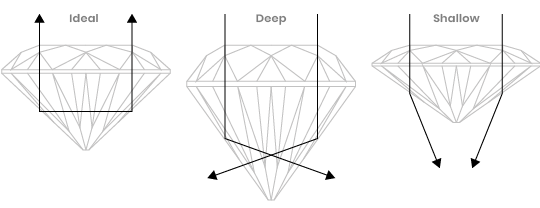Choose your Diamond
Choosing the perfect diamond ring can be sometimes tricky considering how many options there are on the market. When choosing the “perfect” diamond is crucial to understand these 4 features. Therefore, we have provided you with that will hopefully help you to know what kind of ring will be suited for your significant “one”.
Understanding the 4 C’s of Diamonds Shopping
When choosing the it all comes down to the 4’c even though it might sound complicated we will help you to debunk the confusion and choose the “perfect” ring. All of these will have an effect on the ultimate price of the ring.
Diamond Anatomy & Cut Quality
Before going to the 4c’s it is important to take account of the diamonds anatomy. The cut quality should not be mistaken with the shape of the diamond. Knowing the anatomy of the diamond can help you determine diamonds cut grade, which is the most crucial feature.


Diamond Anatatomy Descriptions
Table This is the horizontal facet of diamond. Average table size is expressed as a percentage of the diamond’s average girdle diameter.
Depth The height of a gemstone that is measured from culet to the table
Pavilion The bottom portion of diamonds that extends from girdle to culet
Crown The top portion of diamond extending from girdle to the table
Girdle The intersection of the crown and pavilion defines the perimeter of the diamond.
Culet The facet at the tip of a gemstone. The preferred culet is not visible with yes
! to maximaze your budget, choose the highest cut grade your budget allows
Suggested cut
Less than 1 % – very rare –
Top 3% Ideal Cut – reflects more light than enters
Best combination of Beauty & Value
Top 15% Very good cut – nearly reflects as much light as an ideal cut
Top 25% Good cut
Top 35% Poor/Fair cute
Clarity
It is is crucial to choose which grade of clarity will be your diamond. Diamonds with fewer inclusions look cleaner and light can pass through them easily, making them sparkle. These ones with most clarity are VSS1 and IF.


Diamond Clarity Descriptions
Rare find
IF Diamond that has even patterns in the darker areas.
Excellent Quality
VVS1
VVS2
Best value and most common
VS1
VS2
SI1
SI1
SI2
Poor quality
I1
I2
I3
Cut (Shape)
This might come as a surprise, however, Out of all the factors this as cut does not refer to diamond shape but diamond’s proportions. It can also affect how does the hand looks.


Diamond Cut Descriptions
Emerald
– is an elongated, rectangular and chiseled step cuts with straight linear facets
– deep quality and large surface table.
– rectangle shape is more prominent however can be in square shaped as well
– suitable for wide fingers
Marquise
– can maximaze carat weight giving a much larger looking diamond
– the makes fingers appear long and slender
Pear
– also called “teardrop” – single point and rounded end
– suitable for short fingers – slimming effect
Oval
– this is the most popular and common
– suitable for short fingers – helps to elongate
Round
– most popular and most researched shape
– flexibility when balancing cut/color/ clarity grades
– work well with long fingers
Princess
– most popular after round
– when finding the dimension, important to look at length- to – width ratio
– work well with small hands and long fingers
Cushion
– larger facet enhances diamond’s clarity
– available in shapes from square to rectangle
– length- to width ratio will determine diamond’s outline
Asscher
– nearly identical to emerald but square
– highlights clarity of the diamond
– non-round diamond the color may be slighly visible in its corners
Heart
– distinctive choice
– color may be slightly visible
– length – to- with ratio will determine the outline and when viewed from top
Radiant
– popular and most versatile
– length-to-width ratio determine the look from the top
Remarks…
When having big knuckles – look at thicker heavier bands – draw attention to the ring instead of the middle of the finger
When having slender fingers- smaller stones and thicker bands help make them appear wider
Color
Diamonds come in wide color change from blues or pinks. However, in white diamond, although the more yellow tint has will lower the price, which might seem like a good deal. The more true color it will reflect, and thus the greater the value. It is considered the second most important factor.


Diamond Color Descriptions
Highest Quality – Colorless diamonds
D – extremely rare
E
F
Best Value – near colorless value
G
H
Great with yellow
I
J
K
L
Poor and Yellow
M-Z
Carat (Size)
This is the measurement of how much the diamond weight not how big it is. Each carat can be subdivided into 100 points. Indeed diamond price increases with carat since the diamond is more rare.


Diamond Sizing Descriptions
0.10ct.
0.25ct,
The most common
0.50 ct
0.75ct
1.00ct
1.25ct
1.50ct
1.75ct
2.00ct
2.50ct
! Keep in mind the smaller the finger the bigger the diamond will appear.
Important Remarks and tips…
– Buy a smaller diamond that has less carats that but is well cut. If you buy many carats, it might be large, however might look dull. Good cut diamond can hide color, hide inclusions and appear larger.
– Thin bands can make diamond give the illusion of appearing larger than they actually are
– Last but not least, be mindful of your budget, get something that you can afford. Most importantly, remember the ring is symbol of your love and deep bond that you with your future spouse share rather than a competition with your co-workers or friends.
